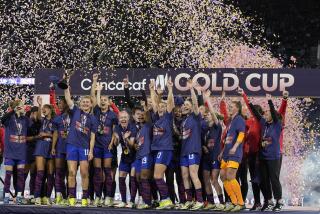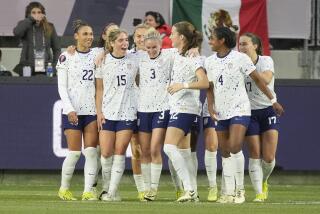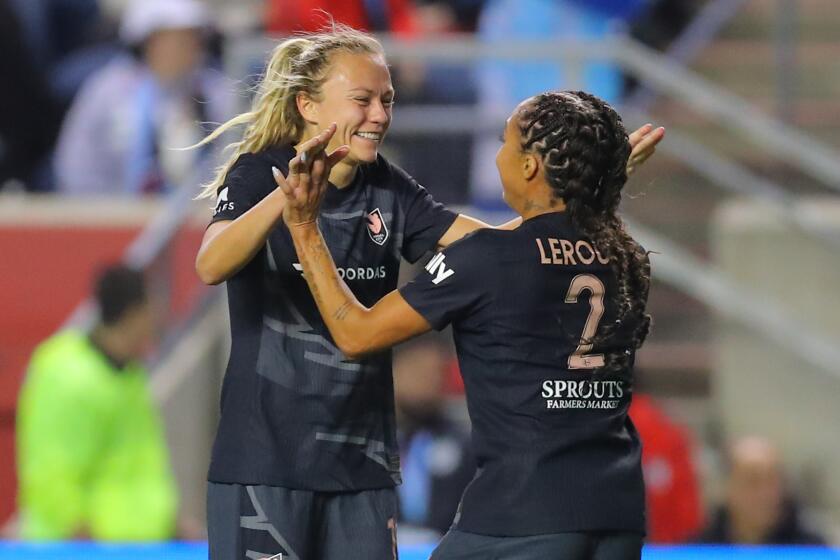With a tweak in its formation, everything changed for U.S. women’s soccer team
Megan Rapinoe has started in two World Cup finals and won an Olympic gold medal with the U.S. women’s national soccer team.
She’s played with two world players of the year in Abby Wambach and Carli Lloyd and with one of the best goalkeepers in history in Hope Solo. Since she debuted with the team a dozen years ago, the U.S. has won 222 games and lost just 32.
Yet Rapinoe said she’s never played on a team as good as the one she’s on now.
“This team is, pound for pound, more talented than any team that I’ve been on,” she said. “You could tell that the younger players just had something different about them. It was just a matter of putting it all together.”
That latter task took the better part of two years, beginning with the Americans’ unexpected early exit from the 2016 Summer Olympics. After the U.S. lost its quarterfinal to Sweden on penalty kicks and left the Games empty-handed for the first time, coach Jill Ellis doubled down on a renovation project that began shortly after her team won the 2015 World Cup.
Four of the players who were on the field for the World Cup final did not play in the quarterfinal in Brazil. And five women who were on the field against Sweden did not play in Sunday’s 6-0 semifinal rout of Jamaica in the CONCACAF Women’s Championship, the victory that qualified the U.S. for next summer’s World Cup in France.
But it wasn’t so much who played as where they played that has made the difference.
In the second half of a 1-0 loss to France 15 months ago – the team’s third scoreless loss at home in seven games – Ellis changed formation, ending her experiment with a three-woman back line in favor of a 4-3-3.
“For us, a lot of it was nailing down what system we wanted to play in terms of what fit us,” Ellis said. “That was part of the process of finding out where our best players on the field do the best things.
“From there, it was just a matter of getting better at it and learning more of the nuances of the system. We had the quality in the players, it was now starting to put the pieces together.”
Next up is Canada, who the U.S. will face in Wednesday’s tournament final, a game in which there’s little tangible on the line for either side. Simply by reaching the final, both teams have already claimed spots in the World Cup, but a win Wednesday could bring a slightly better seed as well as neighborhood bragging rights.
The game with Canada, ranked fifth in the world, will mark another test for a U.S. team that hasn’t lost since changing formations, going 22-0-3 and averaging more than 3½ goals a game. And it has continued to evolve during that streak, more prominently by moving Julie Ertz, a World Cup starter at center back, into a holding role in the midfield and pushing Crystal Dunn, a former NWSL scoring champion, from forward to left back.
In its four games in the CONCACAF qualifying tournament, the top-ranked Americans have outscored their opponents 24-0 and outshot them 143-10.
That level of success has forced Ellis to judge her team’s performances differently. Since making the World Cup was never really an issue – the U.S. is 31-1 all-time in World Cup qualifiers – the coach has focused on her team’s execution, its intensity and the chemistry among players.
“We talked about qualifying but it’s also how we qualified in terms of how we played,” she said.
Keeping that going is Ellis’ next challenge. The World Cup is still eight months away and since the U.S. has played seven teams ranked in the top eight in the world during its unbeaten streak, each has had plenty of time to adjust to the Americans’ new style of play.
So will she adjust again before then?
“That’s a big crystal ball you’re asking me to look at,” she said with a smile. “The players in this group are players that have kind of come through the gauntlet in terms of being challenged and showing their quality. We’ve got a lot of depth, we’ve got a lot of talent.
“It’s about us getting better and continuing the raise the bar on ourselves.”
kevin.baxter@latimes.com | Twitter: @kbaxter11







